The NVIDIA GeForce GTX 1080 & GTX 1070 Founders Editions Review: Kicking Off the FinFET Generation
by Ryan Smith on July 20, 2016 8:45 AM ESTGrand Theft Auto V
The latest edition of Rockstar’s venerable series of open world action games, Grand Theft Auto V was originally released to the last-gen consoles back in 2013. However thanks to a rather significant facelift for the current-gen consoles and PCs, along with the ability to greatly turn up rendering distances and add other features like MSAA and more realistic shadows, the end result is a game that is still among the most stressful of our benchmarks when all of its features are turned up. Furthermore, in a move rather uncharacteristic of most open world action games, Grand Theft Auto also includes a very comprehensive benchmark mode, giving us a great chance to look into the performance of an open world action game.
On a quick note about settings, as Grand Theft Auto V doesn't have pre-defined settings tiers, I want to quickly note what settings we're using. For "Very High" quality we have all of the primary graphics settings turned up to their highest setting, with the exception of grass, which is at its own very high setting. Meanwhile 4x MSAA is enabled for direct views and reflections. This setting also involves turning on some of the advanced redering features - the game's long shadows, high resolution shadows, and high definition flight streaming - but it not increasing the view distance any further.
Otherwise for "High" quality we take the same basic settings but turn off all MSAA, which significantly reduces the GPU rendering and VRAM requirements.


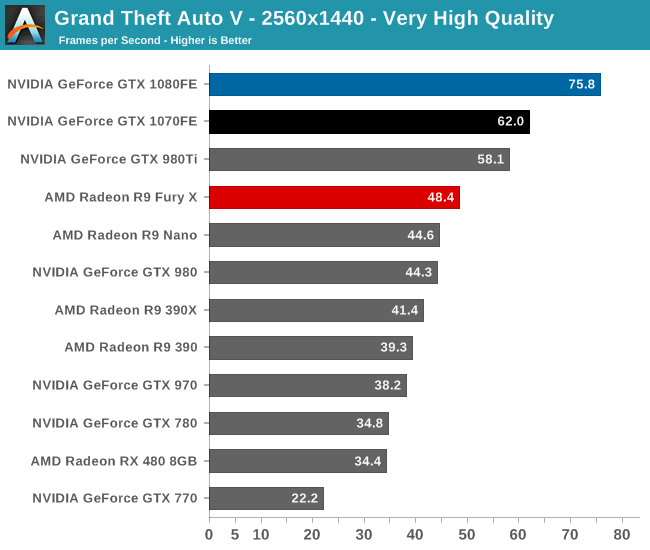
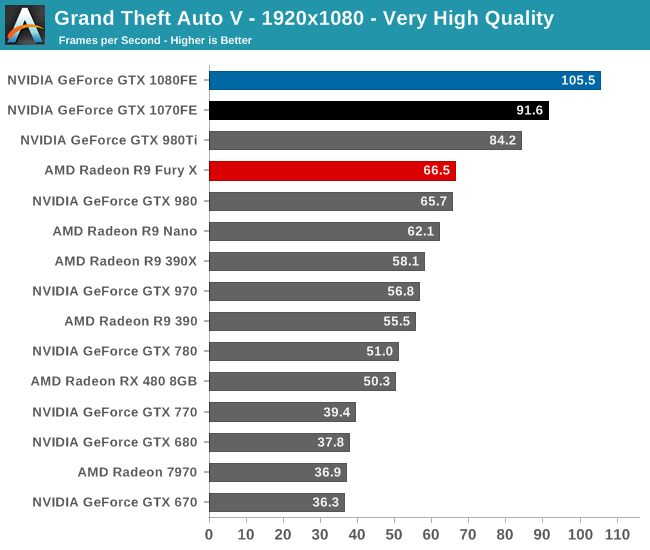
GTA V is another game that in recent times has favored NVIDIA GPUs, and as a result the GTX 1080 enjoys a solid standing here. At 61.4fps, the card becomes the first card to crack 60fps at 4K, albeit at only High quality. For very high quality, it becomes the first card to crack 30fps, both reinforcing how much of an improvement the card is over the previous generation and at the same time highlighting that it’s still going to have to make quality tradeoffs for 60fps at 4K.
Second to only the GTX 1080 is of course the GTX 1070. 4K is arguably out of the question, but at 1440p it can do just better than 60fps, making it the second card to do so. And though largely symbolic, it manages to do so when the GTX 980 Ti could not.
Looking at the generational improvements, GTA shows slightly better than average scaling with the new Pascal cards. GTX 1080 holds a anywhere between a 61% and 71% lead over the GTX 980, with particularly good gains above 1080p. Meanwhile GTX 1070 averages just shy of 60% over its GTX 970 counterpart.
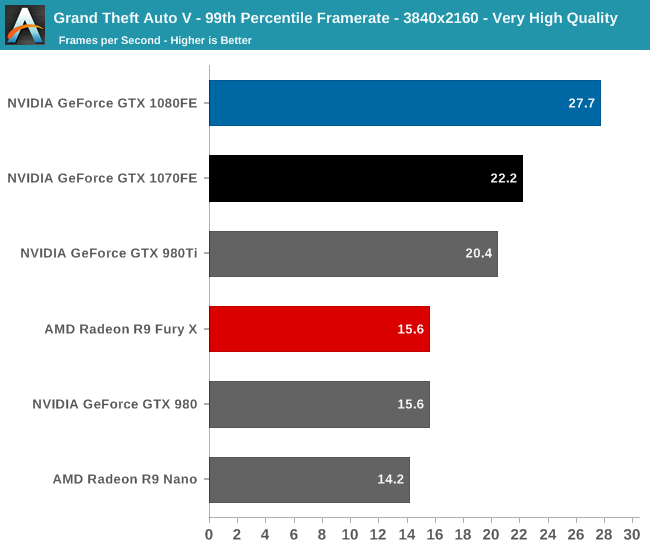
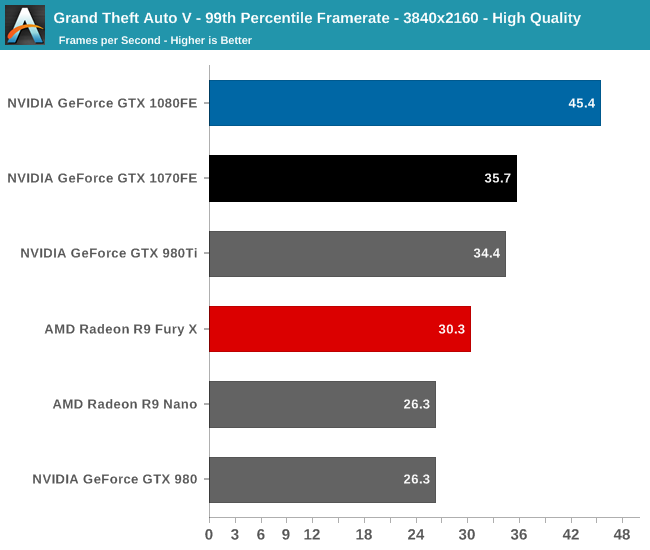
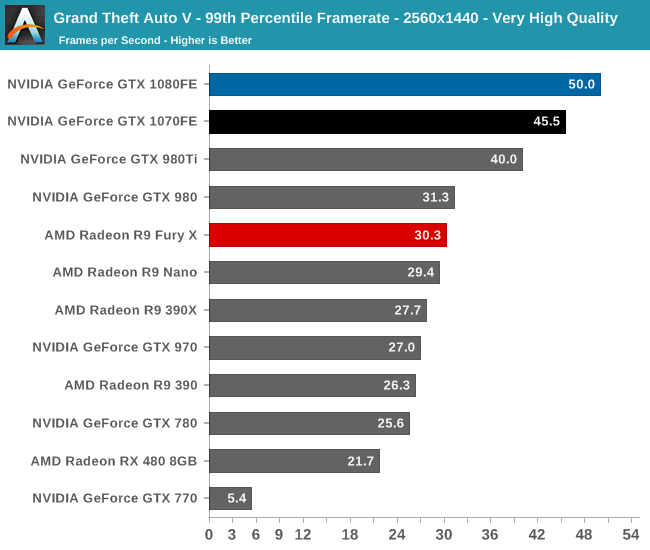
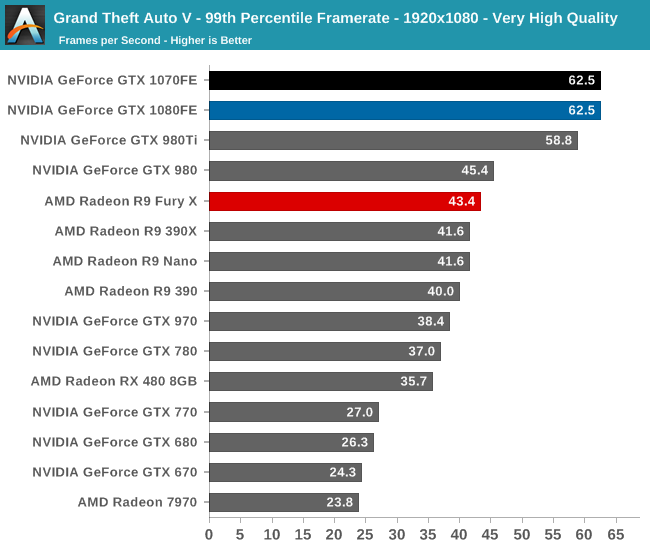










200 Comments
View All Comments
Ninhalem - Wednesday, July 20, 2016 - link
There's 32 freaking pages in this review. Maybe people have other jobs instead of writing all day long. Did you ever think of that?I'll take quality and a long publishing time over crap and rushing out the door.
Stuka87 - Wednesday, July 20, 2016 - link
Thanks for the extremely in depth review Ryan!cknobman - Wednesday, July 20, 2016 - link
I cannot help feel just a bit underwhelmed.Of course these Nvidia cards kick some major butt in games that have always favored Nvidia but I noticed that in games not specifically coded to take advantage of Nvidia and furthermore games with DX12 that these cards performance advantage is minimal at best vs an old Fury X with half the video RAM.
Then when you take into account Vulcan API and newer DX12 games (which can be found elsewhere) you see that the prices for these cards is a tad ridiculous and the performance advantage starts to melt away.
I am waiting for AMD to release their next "big gun" before I make a purchase decision.
I'm rocking a 4k monitor right now and 60fps at that resolution is my target.
nathanddrews - Wednesday, July 20, 2016 - link
1080 is close to being that 4K60 card, but can't quite cut it. I'm waiting for "Big Vega" vs 1080Ti before dropping any money.lefty2 - Wednesday, July 20, 2016 - link
Great review - one of the few that highlights the fact the Pascal async compute is only half as good as AMD's version. Async compute is a key feature for increasing performance in DX12 and Vulkan and that's going to allow the RX 480 to perform well against the GTX 1060Daniel Egger - Wednesday, July 20, 2016 - link
"... why the memory controller organization of GP104 is 8x32b instead of 4x64b like GM204"Sounds like it's the other way around.
Ryan Smith - Wednesday, July 20, 2016 - link
No, that's correct. 8 32bit wide controllers rather than 4 64bit wide controllers.http://images.anandtech.com/doci/10325/GeForce_GTX...
http://images.anandtech.com/doci/8526/GeForce_GTX_...
DominionSeraph - Wednesday, July 20, 2016 - link
>It has taken about 2 years longer than we’d normally see... for a review of a flagship card to come out
sgeocla - Wednesday, July 20, 2016 - link
The old Maxwell was so optimized it was always full and didn't even need Async Compute. The new Pascal is so much more optimized that it even has time to create the "holes" in execution (not counting the ones in your pocket) that were "missing" in the old architecture to be able to benefit for Async Compute. Expect Volta to create even more holes (with hardware support) for Async Compute to fill.tipoo - Wednesday, July 20, 2016 - link
That's demonstrably untrue.http://www.futuremark.com/pressreleases/a-closer-l...
Plenty of holes that could have been filled in Maxwell.